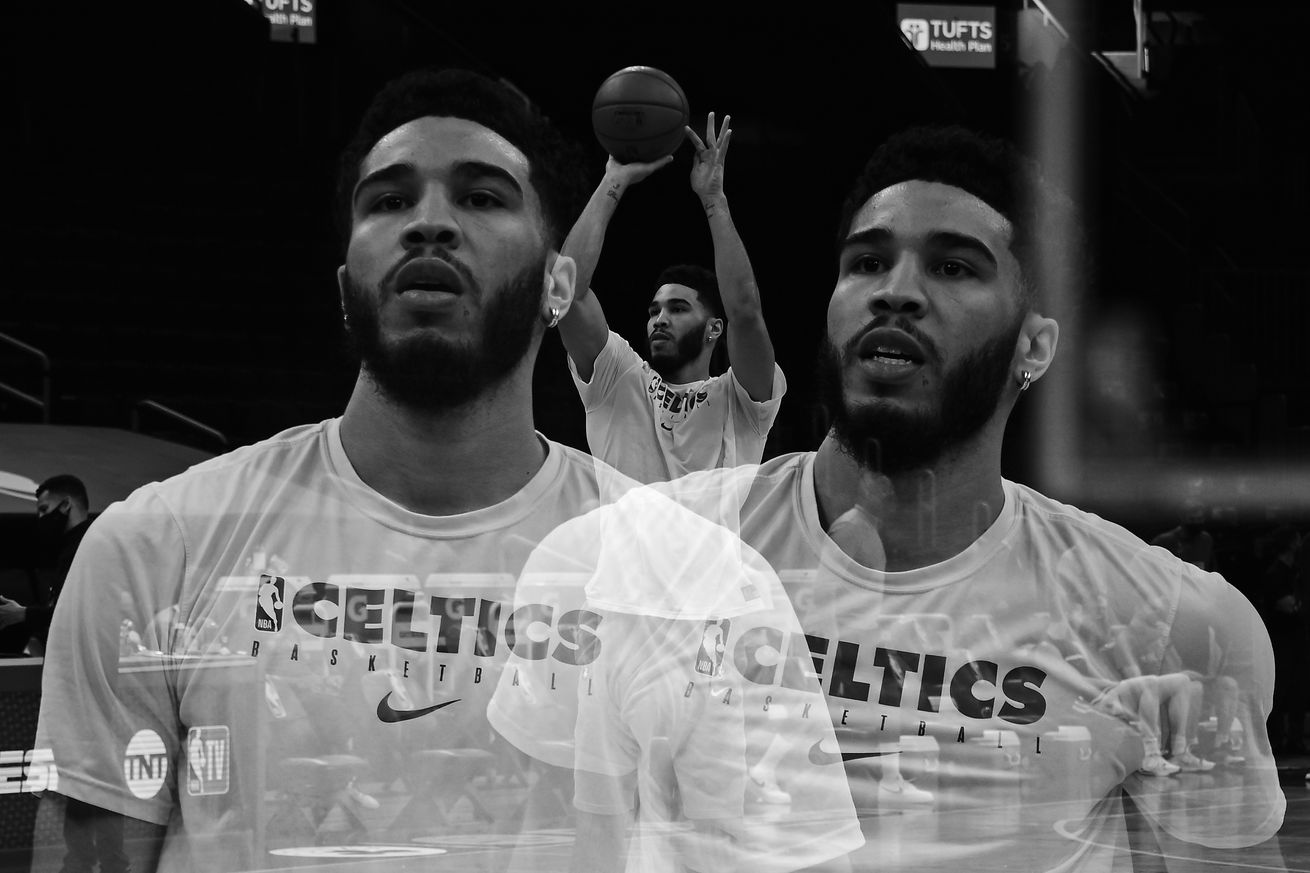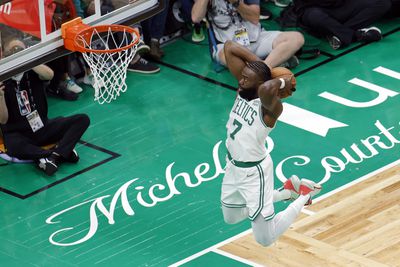
An emotional fan meets an analytical one as I navigate the highs, lows, and nuances of being a Celtics fan and NBA observer.
Note: This article is a translation of an earlier piece written in French for QiBasket.
Since I started writing for CelticsBlog, I think I’ve finally understood the way I watch the NBA. I’ve been watching NBA games on a more or less daily basis for over 10 years, and yet I’ve always felt a kind of irregularity in how I scrutinize those 48 minutes — a feeling that two perspectives lie dormant within me, each with different and sometimes contradictory opinions and ways of operating.
I can’t help but get excited by Jaylen Brown’s incredible dunk on Maxi Kleber—a violent poster that he followed up by slapping the hand of KG, who had come to celebrate the retirement of his jersey at TD Garden. Part of me (let’s call him Smith) immediately thinks that Jaylen Brown is a ferocious forward, capable of creating mismatches and finishing at the rim in any situation.

qPhoto by Danielle Parhizkaran/The Boston Globe via Getty Images
But then, why not make him the franchise player? After all, he’s just shown that he’s capable of getting on top of a defender after dribbling past another. Yet once the game is over, the other perspective takes over and invites me to compare Jaylen Brown’s efficiency with his contemporaries.
This other perspective (let’s call it Taylor) scrolls down to Jaylen Brown’s Basketball Reference page and shows me that, in reality, he’s not all that efficient. A TS+ of 100 reveals that his efficiency is right on par with the NBA average. And, to make matters worse, Taylor points out that with his Usage%, Brown is already very responsible offensively.
So, how can two perspectives in the same mind hold such different opinions and still think their view is the correct one? Which of Smith or Taylor holds the truth, and how do they work?
Smith: living in the moment
Smith operates automatically when I’m watching an NBA game. He has his eyes glued to the ball and doesn’t miss a single crossover, missed pass, or three-pointer. Smith lives entirely in the moment, watching games like a Super Bowl — analyzing based purely on feelings without taking context into account.
Smith is a ball of emotion, a time bomb ready to explode at every highlight. As a Celtics fan, Smith is the part of me that believed Boston could win the title in 2017, with Isaiah Thomas as the franchise player, after his iconic 53-point game against the Wizards. Yet, Taylor and I knew that roster was far too limited and the Celtics were lucky to have beaten the Bulls in the previous round.

Photo by Jim Davis/The Boston Globe via Getty Images
Smith watches games his way—sometimes forgetting context—and this generates opinions that often feel like contradictions to what Taylor is feeling. The problem? He’s sometimes right, which boosts his confidence and makes him more inclined to form strong conclusions.
Because Smith views games in isolation, he analyzes a micro-environment and tries to find truth in a sample that’s too small. For example, Smith thought Paolo Banchero was a future offensive star after watching one game in which Banchero scored 29 points on 10-of-18 shooting and 9-of-11 free throws.

Photo by Maddie Malhotra/Getty Images
That game’s reality, yes, pointed to a high-potential player. But the reality of the season, with comparable usage, showed that only Russell Westbrook during his Lakers stint had been less efficient.
Smith omits critical details—context, statistical trends, and overarching realities—focusing instead on what’s directly in front of him. That’s where Taylor steps in.
Taylor: stepping back to move forward
While Smith is present the moment I switch on League Pass, Taylor is still asleep. The two can hardly coexist during games. Smith focuses on the ball, while Taylor takes a step back, trying to map out the bigger picture:
- What are the five defenders doing, and how does their positioning reflect the coach’s strategy?
- How are the offensive players moving, and where is the ball headed?
Taylor tries to capture the ever-changing context to better understand the game’s flow. This level of analysis, however, is mentally exhausting, which is why Taylor usually works during replays rather than live games at 3 a.m.
Taylor works best after the fact, breaking down plays, comparing them across games, and leveraging statistics to paint a clearer picture. With the emotion of the live game gone, Taylor can dissect every detail calmly.

Photo by Jacob Kupferman/Getty Images
Smith and Taylor’s role in my mind
When I was younger, Smith dominated, leaving little room for Taylor. But over time—through watching games, listening to podcasts, and reading articles—I came to understand Smith’s limitations and gave Taylor more space.
Thanks to Taylor, I’ve learned to set emotions aside and dig deeper. If someone had asked me when I was younger, “Is Paolo Banchero a good forward?”, Smith would’ve confidently said, “Yes, because he scores 20 points a game as a rookie.”
Taylor, however, would have countered with Banchero’s below-average efficiency, insufficient playmaking, and tendency for poor shot selection, while also highlighting his strong ability to draw fouls.

Photo by Scott Eisen/Getty Images
Both would be correct. The problem is that where Taylor answers the nuanced question posed, Smith simplifies it into a question he can answer easily.
So why keep Smith around? Because without Smith, there’d be no Taylor. Smith introduced me to the NBA through its highlights, emotions, and narratives. Without Smith, I wouldn’t get up for every Celtics playoff game, or experience moments like Jayson Tatum’s buzzer-beater against the Nets or Derrick White’s miracle tip-in. Without Smith, I wouldn’t have flown from France to Boston for Marcus Smart’s tribute at TD Garden.
Over time, I’ve found a balance between Smith and Taylor, and I’m ready to experience another season with them as a writer. To conclude, I now invite you to reflect: where do these two perspectives lie within you?
Note: This article was inspired by Daniel Kahneman’s Thinking, Fast and Slow. If you’ve read it, you’ll likely recognize its influence. If you haven’t, I hope you find it intriguing.